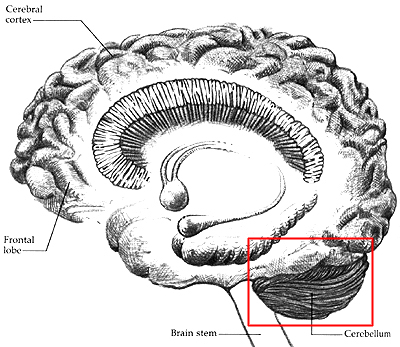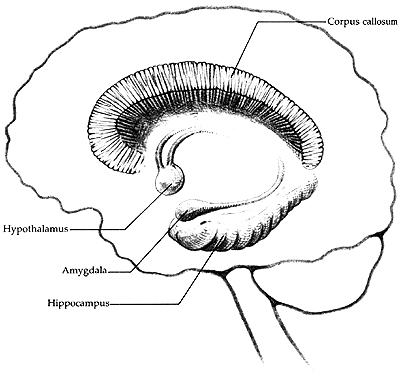CEREBELLUM:
Hindbrain

General functions:
- Sensory perception.
- Motor output/control.
- Sends information to the muscles causing them to move
- Feedback on the position of the body in space (proprioception).
- Fine-tune motor movements.
- A number of key cognitive functions:
- Attention
- Language processing
- Music
- Sensory stimuli.
Anatomy:
The cerebellum contains similar gray and white matter divisions as the cerebrum. Embedded within the white matter which is known as the arbor vitae (Tree of Life) in the cerebellum due to its branched, treelike appearance are four deep cerebellar nuclei. Three gross phylogenetic segments are largely grouped by general function. The three cortical layers contain various cellular types that often create various feedback and feedforward loops. Oxygenated blood is supplied by three arterial branches off the basilar and vertebral arteries.
General features:
The cerebellum is located in the inferior posterior portion of the head (the hindbrain), directly dorsal to the brainstem and pons, inferior to the occipital lobe (Figs. 1 and 3). Because of its large number of tiny granule cells, the cerebellum contains nearly 50% of all neurons in the brain, although it constitutes only 10% of total brain volume. The cerebellum receives nearly 200 million input fibers; in contrast, the optic nerve is composed of a mere one million fibers.
The cerebellum is divided into two large hemispheres, much like the cerebrum, and contains ten smaller lobules. The cytoarchitecture (cellular organization) of the cerebellum is highly uniform, with connections organized into a rough, three-dimensional array of perpendicular circuit elements. This organizational uniformity makes the nerve circuitry relatively easy to study. To envision this "perpendicular array", imagine a tree-lined street with wires running straight through the branches of one tree to the next.
Theories about Cerebellum functioning:
Two main theories address the function of the cerebellum. One claims that the cerebellum functions as a regulator of the "timing of movements". This has emerged from studies of patients whose timed movements are disrupted[4]. The other theory claims that the cerebellum operates as a learning machine, encoding information as does a computer. This was first proposed by Marr and Albus in the early 1970s[5].
Like many controversies in the physical sciences, there is evidence supporting parts of both hypotheses. Studies of motor learning in the vestibulo-ocular reflex and eyeblink conditioning demonstrate that the timing and amplitude of learned movements are encoded by the cerebellum[6]. Many synaptic plasticity mechanisms have been found throughout the cerebellum. The Marr-Albus model mostly attributes motor learning to a single plasticity mechanism: the long-term depression of parallel fiber synapses.
With the advent of more sophisticated neuroimaging techniques such as positron emission tomography (PET)[7] and fMRI[8], numerous diverse functions are now at least partially attributed to the cerebellum. What was once thought to be primarily a motor/sensory integration region is now proving to be involved in many diverse cognitive functions. Paradoxically, despite the importance of this region and the heterogeneous role it plays in motor and sensory functions, people who have lost their entire cerebellum through disease, injury, or surgery can live reasonably normal lives.
|








